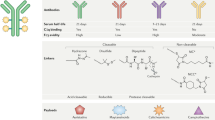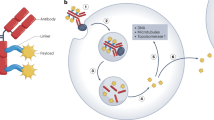Abstract
We have designed a new pathway for the synthesis of targeted polymeric drug delivery systems, using polymerizable antibody Fab′ fragments (MA-Fab′). The targeted systems can be directly prepared by copolymerization of the MA-Fab′, N-(2-hydroxypropyl)methacrylamide (HPMA) and drug-containing monomers. Both MA-Fab′ and the Fab′-targeted copolymers can effectively bind to target cells. An MA-Fab′ (from OV-TL 16 Ab) targeted HPMA copolymer containing mesochlorin e6 (Mce6) was synthesized by copolymerization of MA-Fab′, HPMA, and MA-GFLG-Mce6. The targeted copolymer exhibited a higher cytotoxicity toward OVCAR-3 human ovarian carcinoma cells than the nontargeted Mce6-containing copolymer or free Mce6. The targeted copolymer was internalized more efficiently by OVCAR-3 cells than the nontargeted copolymer.
This is a preview of subscription content, access via your institution
Access options
Subscribe to this journal
Receive 12 print issues and online access
$209.00 per year
only $17.42 per issue
Buy this article
- Purchase on Springer Link
- Instant access to full article PDF
Prices may be subject to local taxes which are calculated during checkout




Similar content being viewed by others
References
Putnam, D. & Kopecek, J. Polymer conjugates with anticancer activity. Adv. Polym. Sci. 122, 55– 123 (1995).
Maeda, H., Seymour, L.M. & Miyamoto, Y. Conjugates of anticancer agents and polymers: advantages of macromolecular therapeutics in vitro. Bioconjugate Chem . 3, 351–362 (1992).
Vasey, P.A. et al. Phase I clinical and pharmacokinetic study of PK1 [N-(2-hydroxypropyl)methacrylamide copolymer doxorubicin]: first member of a new class of chemotherapeutic agents—drug–polymer conjugates. Clin. Cancer Res. 5, 83– 94 (1999).
Caiolfa, V.R. et al. Novel perspectives in topoiosmerase-I inhibitor-based chemotherapy of solid tumors: MAG-camptothecin conjugates. Abstr. Ninth Intl. Symp. Recent Adv. Drug Delivery Systems. Salt Lake City, UT, February 22, 1999, p. 46.
Fritzberg, A.R. Biorecognition of antibodies in vivo: potential in drug targeting. J. Mol. Recognition 9, 309–315 (1996).
Omelyanenko, V., Kopecková, P., Gentry, C., Shiah, J.-G., & Kopecek, J. HPMA copolymer–anticancer drug–OV-TL 16 antibody conjugates. 1. Influence of the method of synthesis on the binding affinity to OVCAR-3 ovarian carcinoma cells in vitro. J. Drug Targeting 3, 357–373 (1996).
Ríhová, B. et al. Antibody-directed affinity therapy applied to the immune system: in vivo effectiveness and limited toxicity of daunomycin conjugated to HPMA copolymers and targeting antibody. Clin. Immunol. Immunopathol. 46, 100–114 (1988).
Auditore-Hargreaves, K. et al. Phase-separation immunoassays. Clin. Chem. 33, 1509–1516 (1987).
Monji, N. & Hoffman, A.S. A novel immunoassay system and bioseparation process based on thermal phase separating polymers. Appl. Biochem. Biotech. 14, 107–119 (1987).
Fritzberg, A.R., Beaumier, P.L., Bottino, B.J. & Reno, J.R. Approaches to improved antibody- and peptide-mediated targeting for imaging and therapy of cancer. J. Controlled Release 28, 167–173 (1994).
Boerman, O. et al. Comparative in vitro binding and biodistribution in tumor-bearing athymic mice of anti-ovarian carcinoma monoclonal antibodies. Anticancer Res. 10, 1289–1296 (1990).
Boerman, O. et al. Monoclonal antibodies against ovarian carcinoma-associated antigens, raised by immunization with cyst fluids. Anticancer Res. 9, 551–558 (1989).
Lu, Z.-R., Kopecková, P. & Kopecek, J. Polymerizable Fab' antibody fragments. Proc. Intl. Symp. Controlled Release Bioactive Mater. 25, 788–789 (1998).
Parham, P. On the fragmentation of monoclonal IgG1, IgG2a, and IgG2b from Balb/c mice. J. Immunol. 131, 2895–2902 (1993).
Parham, P., Androlewicz, M.J., Brodsky, F.M., Holmes, N.J. & Ways, J.P. Monoclonal antibodies: purification, fragmentation and application to structural and functional studies of class I MHC antigens. J. Immunol. Methods 53, 133–173 (1982).
Peterson, C.M. et al. Combination chemotherapy and photodynamic therapy with N-(2-hydroxypropyl)methacrylamide copolymer-bound anticancer drugs inhibit human ovarian carcinoma heterotransplanted in nude mice. Cancer Res. 56, 3980– 3985 (1996).
Rejmanová, P., Pohl, J., Baudys, M., Kostka, V. & Kopecek, J. Polymers containing enzymatically degradable bonds. 8. Degradation of oligopeptide sequences in N-(2-hydroxypropyl)methacrylamide copolymers by bovine spleen cathepsin B. Makromol. Chem. 184, 2009–2020 (1983).
Omelyanenko, V., Gentry, C., Kopecková, P. & Kopecek, J. HPMA copolymer–anticancer drug–OV-TL16 antibody conjugates. II. Processing in epithelial ovarian carcinoma cells in vitro. Int. J. Cancer 75, 600–608 (1998).
Delgado, C. et al. Enhanced tumor specificity of an anticarcinoembrionic antigen Fab' fragment by poly(ethylene glycol) (PEG) modification. Br. J. Cancer 73, 175–182 (1996).
Drobník, J. et al. Enzymatic cleavage of side chains of synthetic water-soluble polymers. Makromol. Chem. 177, 2833– 2848 (1976).
Kopecek, J. & Bazilová, H. Poly[N-(2-hydroxypropyl)methacrylamide]. 1. Radical polymerization and copolymerization. Eur. Polym. J. 9, 7–14 (1973 ).
Kopecek, J. et al. Synthetic polymeric drugs. U.S. Pat. 5,037,883 (Aug. 6, 1991).
Acknowledgements
We thank Dr. L. Poels (University of Nijmegen, The Netherlands) for the generous gift of the hybridoma producing OV-TL 16 antibody, and Dr. Z. Wu for collecting the MALDI-TOF mass spectra of the antibody and its fragments. This research was supported in part by NIH grant CA51578 from the National Cancer Institute, and by the Center for Biopolymers at Interfaces, University of Utah.
Author information
Authors and Affiliations
Corresponding author
Rights and permissions
About this article
Cite this article
Lu, ZR., Kopečková, P. & Kopeček, J. Polymerizable Fab′ antibody fragments for targeting of anticancer drugs. Nat Biotechnol 17, 1101–1104 (1999). https://doi.org/10.1038/15085
Received:
Accepted:
Issue Date:
DOI: https://doi.org/10.1038/15085
This article is cited by
-
RETRACTED ARTICLE: Stem cell membrane–camouflaged bioinspired nanoparticles for targeted photodynamic therapy of lung cancer
Journal of Nanoparticle Research (2020)
-
Electrochemical Study of Core-Shell Microgels
Polymer Bulletin (2008)



